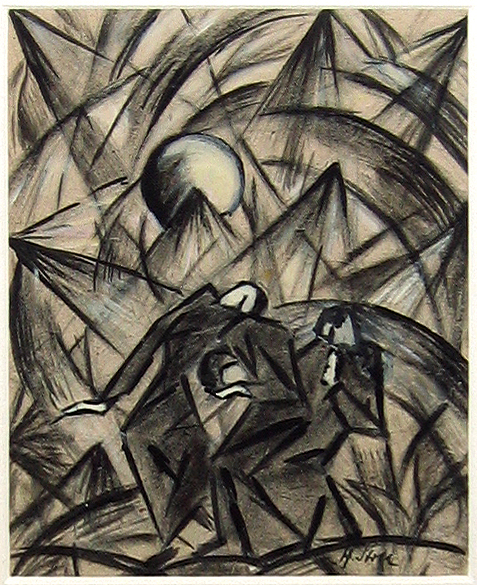HANNS STOLL
HANNS STOLL (German, 1889-1949)
„Nach Markus Evangelium , 13. 24“ , 1910s
ink and charcoal on paper laid down on board, 21cm X 17cm.
„Aber in jenen Tagen, nach der großen Not, wird sich die Sonne verfinstern und der Mond wird nicht mehr scheinen; die Sterne werden vom Himmel fallen und die Kräfte des Himmels werden erschüttert werden“ (Markus 13, 24)
„But in those days, after that suffering, the sun will be darkened, and the moon will not give its light, and the stars will be falling from heaven, and the powers in the heavens will be shaken“ (Markus 13, 24)
Please compare to his ink drawing „Solacement“ in the section „Figure“.
Hanns Stoll was born in 1889 in Schleusingen. He started to study philology in Marburg and continued at the art academy Munich. In the following years he lived in Magdeburg, Schleusingen and during the winter time in Berlin where he kept an attic studio at the Kurfürstendamm 23. He served in WWI and was awarded the „Bair. Verdienstorden 3. Klasse“. Stoll is best known for his traditional landscapes in which he followed a romantic ideal like Overbeck or Caspar David Friedrich. The both drawings of the collection were executed in Berlin and show a quite progressive artistic concept. His studio in Berlin and part of his oeuvre was destroyed in a 1945 bombing. After the war, he lived in Schleusingen and died there after a severe illness in 1949.
Lit.: Weitze, Hans-Werner: Schleusingen – Bilder und Notitzen zum Kulturleben seit 1815. Stuttgart, 1981.
Freies Wort, Volkszeitung: Hanns-Stoll-Ausstellung, Suhl, 1973.
Naturhistorisches Museum Schloss Bertholdsburg Schleusingen, Typoscript: Erinnerungen an Hanns Stoll.

